Lou’s Views
News & Views / April Edition
Calendar of Events –

Days at the Docks Festival
April 27th & 28th
Holden Beach
The annual festival which started in the 1980’s occurs in April or May and is sponsored by the Greater Holden Beach Merchants Association. It’s the Holden Beach way to kick-off the Spring and start the vacation season. In addition to the food and arts & crafts, enjoy live music & entertainment, a horseshoe tournament and the world famous “Bopple Race”. Lots of activities for the entire family!
For more information » click here

Strawberry & Wine Fest
April 28th
Sunset Beach
.
The Strawberry and Wine Festival, hosted by the Old Bridge Preservation Society since 2014. There will be wines available from Silver Coast Winery with strawberries as the main fare of the day. It’s a day of wine, food, entertainment, and craft vendors.
For more information » click here

Blue Crab Festival
May 18th & 19th
Little River SC
.
Little River has been celebrating the World Famous Blue Crab Festival since 1981. It is held on the waterfront in Little River and is one of the largest festivals in the Southeast. The purpose of this festival is one that supports and showcases the fabulous atmosphere of the local communities.
For more information » click here
 Discover a wide range of things to do in the Brunswick Islands for an experience that goes beyond the beach.
Discover a wide range of things to do in the Brunswick Islands for an experience that goes beyond the beach.
For more information » click here.
Calendar of Events Island –

Concerts on the Coast Series
The Town’s summer concert series calendar has been released! Live performances featuring local musical groups will temporarily be held at the Bridgeview Park picnic pavilion on Sunday evenings from late May to early September. The concerts are free of charge.
For more information » click here
Parks & Recreation / Programs & Events
For more information » click here
Reminders –
 THB Newsletter (03/30/24)
THB Newsletter (03/30/24)
Paid Parking
Paid parking will be enforced starting April 1st in all Holden Beach designated parking areas. It will be enforced from 9:00 a.m. – 5:00 p.m. daily, with free parking before and after that time. All parking will use license plates for verification.
As a reminder, Holden Beach uses the “SurfCAST by Otto” parking solution. Annual passes are now available for purchase on the mobile app. You will also be able to purchase passes by scanning the QR-codes located on the parking signs for access to https://surfcast.ottoconnect.us/pay.
Rates for the 2024 season are as follows:
$5 per hour for up to four hours
$20 per day and for any duration greater than four hours
$80 per week (seven consecutive days)
$175 per calendar year for a single vehicle (annual passes)
Handicap parking is free in designated handicap spaces and only with a valid license plate or hangtag.
Parking rates can be paid via credit card, debit card or PayPal.
Visit https://hbtownhall.com/paid-parking for more information and to view a table with authorized parking areas.

Pets on the Beach Strand
Pets – Chapter 90 / Animals / 90.20
From May 20th through September 10th it is unlawful to have any pet on the beach strand during the hours of 9:00am through 5:00pm.

Solid Waste Pick-Up Schedule
GFL Environmental change in service, trash pickup will be twice a week.Starting the Saturday before Memorial Day through the Saturday after Labor Day: Pick-up is every Tuesday and Saturday from May 25th through September 30th
Please note:
. • Trash carts must be at the street by 6:00 a.m. on the pickup day
. • BAG the trash before putting it in the cart
. • Carts will be rolled back to the front of the house
GFL Refuse Collection Policy
GFL has recently notified all Brunswick County residents that they will no longer accept extra bags of refuse outside of the collection cart. This is not a new policy but is stricter enforcement of an existing policy. While in the past GFL drivers would at times make exceptions and take additional bags of refuse, the tremendous growth in housing within Brunswick County makes this practice cost prohibitive and causes drivers to fall behind schedule.
Solid Waste Pick-up Schedule –
starting the Saturday before Memorial Day (May 25th) twice a week
Recycling –
starting after Memorial Day (June 4th) weekly pick-up
Curbside Recycling – 2024
GFL Environmental is now offering curbside recycling for Town properties that desire to participate in the service. The service cost per cart is $106.88 annually paid in advance to the Town of Holden Beach. The service consists of a ninety-six (96) gallon cart that is emptied every other week during the months of October – May and weekly during the months of June – September.
Curbside Recycling Application » click here
Curbside Recycling Calendar » click here

Trash Can Requirements – Rental Properties
GFL Environmental – trash can requirements
Ordinance 07-13, Section 50.08
Rental properties have specific number of trash cans based on number of bedrooms.
* One extra trash can per every 2 bedrooms
..
§ 50.08 RENTAL HOMES.
(A) Rental homes, as defined in Chapter 157, that are rented as part of the summer rental season, are subject to high numbers of guests, resulting in abnormally large volumes of trash. This type of occupancy use presents a significantly higher impact than homes not used for summer rentals. In interest of public health and sanitation and environmental concerns, all rental home shall have a minimum of one trash can per two bedrooms. Homes with an odd number of bedrooms shall round up (for examples one to two bedrooms – one trash can; three to four bedrooms – two trash cans; five – six bedrooms – three trash cans, and the like).
Building Numbers
Ocean front homes are required to have house numbers visible from the beach strand.
Please call Planning and Inspections Department at 910.842.6080 with any questions.
§157.087 BUILDING NUMBERS.
(A) The correct street number shall be clearly visible from the street on all buildings. Numbers shall be block letters, not script, and of a color clearly in contrast with that of the building and shall be a minimum of six inches in height.
(B) Beach front buildings will also have clearly visible house numbers from the strand side meeting the above criteria on size, contrast, etc. Placement shall be on vertical column supporting deck(s) or deck roof on the primary structure. For buildings with a setback of over 300 feet from the first dune line, a vertical post shall be erected aside the walkway with house numbers affixed. In all cases the numbers must be clearly visible from the strand. Other placements may be acceptable with approval of the Building Inspector.
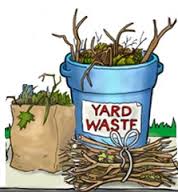 Yard Waste Service
Yard Waste Service
Yard debris pick-up will be provided twice a month on the second and fourth Fridays during the months of March, April, and May. Please have yard waste placed at the street for pick-up on Thursday night. The first pickup of the season is on March 8th. No pick-ups will be made on vacant lots or construction sites.
Debris must be placed in a biodegradable bag or bundled in a length not to exceed five (5) feet and fifty (50) pounds. Each residence is allowed a total of ten (10) items, which can include a combination of bundles of brush and limbs meeting the required length and weight and/ or biodegradable bags with grass clippings, leaves, etc.
 Bird Nesting Area
Bird Nesting Area
NC Wildlife Commission has posted signs that say – Bird Nesting Area / Please don’t disturb. The signs are posted on the west end beach strand around 1307 OBW.
.
People and dogs are supposed to stay out of the area from April through November
. 1) It’s a Plover nesting area
. 2) Allows migrating birds a place to land and rest without being disturbed
Storm Events –

Hurricane Vehicle Decals
Property owners will be provided with four (4) decals which were included in their April water bills. It is important that you place your decals in your vehicle or in a safe place. A $10 fee will be assessed to anyone who needs to obtain either additional or replacement decals. Decals will not be issued in the 24-hour period before an anticipated order of evacuation.
The decals are your passes to get back onto the island to check your property in the event that an emergency would necessitate restricting access to the island. Decals must be displayed in the driver side lower left-hand corner of the windshield, where they are not obstructed by any other items. Officials must be able to clearly read the decal from outside the vehicle.
Property owners without a valid decal will not be allowed on the island during restricted access. No other method of identification is accepted in an emergency situation. Click here to visit the Town website to find out more information regarding decals and emergency situations.
EVACUATION, CURFEW & DECALS
What is a State of Emergency?
A proclamation by the Town which enacts special ordinances and/or prohibitions during emergency situations to protect the public, public health and property. These prohibitions can include limitations on movement, curfews, directing of evacuations, controlling ingress and egress to the emergency area, alcoholic beverages, and more. State of Emergencies are issued in accordance with N.C.G.S. 166A-19.22.
What is a curfew?
A curfew is an order, typically during a State of Emergency, which requires all persons in the affected areas to remain on their own property. During a curfew, you are not free to move about public domain areas or on others’ property. Violations of a curfew could lead to arrest in certain situations.
What is a voluntary evacuation?
A voluntary evacuation creates a recommendation for all parties in the affected area to get their affairs in order hastily and evacuated.
What is a mandatory evacuation?
A mandatory evacuation means you must leave the area in which an order has been issued. With recent changes to the laws in North Carolina, you no longer have the option of staying in an area under an order of mandatory evacuation.
Why is the sewer system turned off during a storm/event?
Often the sewer system is turned off during storms which have the potential to create significant flooding on the island. The system is turned off to protect its integrity. If it were left on, it could pose a significant threat to the public health. When the system is manually shut down, it also greatly reduces the time needed to bring it back up after an event which equates to getting residents and guests back on the Island much faster.
Why is there a delay for decal holders to get back on the island once a storm ends?
After a storm, many things must occur before even limited access can be allowed. Some of those things include making sure the streets are passable; the sewer system must be restarted to comply with State laws; the utilities (water, sewer, electricity, propane supplies) must be checked to ensure no safety risk are present; and the post-storm damage assessment team needs to perform an initial assessment.
Where can I get up-to-date information during and after a storm or State of Emergency?
You can sign up for the Town email service by clicking here. The newsletter, along with the Town’s website will be the main sources of information during an emergency situation. Links to the Town’s official Facebook and Twitter pages can be found on the website. You can also download our app for Apple and Android phones by accessing the app store on your smart phone and searching Holden Beach.
Please refrain from calling Town Hall and Police Department phone lines with general information questions. These lines need to remain open for emergencies, storm management and post-storm mitigation. All updates concerning re-entry, general access, etc. may be found on the Town’s website and other media outlets.
Why do I see others moving about the island during a curfew?
If a curfew order is in place, you must stay on your own property. You may see many other vehicles moving about the Island. We often receive assistance from other local, state, federal and contract personnel during events. It is likely these are the personnel you are seeing, and they are involved in the mitigation process for the event. Please do not assume that a curfew order has been lifted and/or you are free to move about the island.
Can I check my friends’ property for them?
If a curfew order is in place, you may ONLY travel to your personally owned property. Traveling about the Island to check on others’ property is not allowed. is in place, you may ONLY travel to your personally owned property. Traveling about
Who can obtain decals?
Only property owners and businesses who service the island can obtain a decal.
How do I get decals for my vehicle…?
If I am an owner?
Decals will be mailed out in water bills to property owners before the season starts. Those owners who need additional decals can contact Town Hall. A fee may apply, please check the current fee schedule.
If I am a renter?
You must contact the owner of the property to obtain a decal.
If I am a business owner on the Island?
You must contact Town Hall to obtain a decal.
If I am a business owner off the Island that provides services on the Island?
You must contact Town Hall for eligibility and to obtain a decal.
When does my decal expire?
All decals expire on the last day of the calendar year as indicated on the decal.
Where do I put my decal on my car?
Decals must be displayed in the lower left-hand corner of the windshield, where they are not obstructed by any other items to include window tinting, other decals, etc. Officials must be able to clearly read the decal from outside the vehicle. Please note that re-entry will not be allowed if a current, intact decal is not affixed to the windshield as designated.
How do I replace a decal if I get a new vehicle?
If you trade a vehicle or otherwise need a replacement decal, you may obtain them from Town Hall during normal business hours. A fee may apply, check the current fee schedule.
Can I obtain a decal right before an emergency occurs?
While most of the storms we deal with are tropical in nature with some type of advanced warning, we do experience many other types of events that could create a State of Emergency without warning. All eligible parties should obtain decals as early as possible each year to avoid being denied access to the Island. Decals shall not be issued during the 24-hour period prior to an anticipated order of evacuation so staff can concentrate on properly preparing the Town for the storm/event.
Can I use a tax bill or another document for re-entry?
No. You MUST have a decal to re-enter the Island until it is open to the general public.
How does re-entry after a storm during a State of Emergency work?
The bridge is closed to all vehicle access, except for official vehicles. Once those with proper decals are allowed access, they must conform with the current rules in place by the specific State of Emergency Order. After all hazards have been rendered safe, the bridge will be opened to the general public. A curfew could remain in effect however, to ensure the safety and security of the Island and its residents and guests. Please understand this process typically takes days to evolve and could be significantly longer, depending on the amount of damage sustained. Please refrain from calling for times for re-entry, as those are often not set on schedule. Instead, stay tunes to local media outlets and official social media accounts for accurate updates.
How can I check on my property if access is limited to the Island?
Once it is safe, property owners with valid decals will be allowed back on the Island after a storm/event. At this point, you can travel to your property, in accordance with the rules of the specific State of Emergency Order currently in place.
If you live out of the area, please do not travel to the Island until you are certain you will be allowed access. Stay tuned to those media outlets and email services that are of official nature for this information. Also, be certain you have your current, valid decal properly affixed to your vehicle.
It is a good idea to be sure your contact information is current with the Town tax office as this is the location Town officials will use in the event you need to be contacted.
For more information » click here
NC General Statute 166A-19.22
Power of municipalities and counties to enact ordinances to deal with states of emergency.
Synopsis – The governing body may impose by declaration or enacted ordinance, prohibitions, and restrictions during a state of emergency. This includes the prohibition and restriction of movements of people in public places, including imposing a curfew; directing or compelling the voluntary or mandatory evacuation of all or part of the population, controlling ingress and egress of an emergency area, and providing for the closure of streets, roads, highways, bridges, public vehicular areas. All prohibitions and restrictions imposed by declaration or ordinance shall take effect immediately upon publication of the declaration unless the declaration sets a later time. The prohibitions and restrictions shall expire when they are terminated by the official or entity that imposed them, or when the state of emergency terminates.
Violation – Any person who violates any provisions of an ordinance or a declaration enacted or declared pursuant to this section shall be guilty of a Class 2 misdemeanor.
Turtle Watch Program –

Turtle Watch Program – 2024
Members of the patrol started riding the beach every morning on May 1 and will do so through October looking for signs of turtle nests.
For more information » click here
.
Early-season sea turtle false crawl reported in Holden Beach
An early-season sea turtle false crawl was reported Wednesday morning in Holden Beach. “This is surprisingly early, given that no nesting has been reported in Georgia and South Carolina so far this year, and turtle crawls in those states normally precede North Carolina,” local volunteers said. Sea turtle nesting season normally begins in May and runs through November. It is unknown whether this turtle will try to nest in Holden Beach again or elsewhere (including south of NC). To report a crawl, you can call 910-470-2880 or 910-329-0222.
Dates set for summer educational programs
We’ve set our dates for our traditional summer educational programs.
Turtle Talk for all ages will be held on Wednesday evenings at 7 p.m. from June 19 through August 24.
Children’s Turtle Time will be at 4 p.m. on Wednesdays June 26 through August 7. This is for children 3-6 years old.
Both programs are free of charge and will be held at the Holden Beach Chapel.

Upon Further Review –
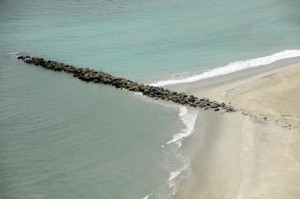
Will the N.C. coast see more terminal groins as erosion continues and sand gets scarcer?
More than a decade after N.C. law was changed to allow the construction of terminal groins, why have only two been built along the coast?
During the middle of President Barack Obama’s first term in office, North Carolina made one of the biggest changes to how it manages oceanfront development since the adoption of the Coastal Area Management Act (CAMA). State legislators approved a bill that softened North Carolina’s long-standing prohibition on hardened structures along the beachfront except in very specific cases, such as to protect historic buildings. The legislation, Senate Bill 110, specifically allowed up to four “test” terminal groins − later increased to six − to be built along the coast. The controversial decision, reinforced by Gov. Bev Perdue allowing it to become law without her signature, ended a 30-year state ban and decades of discussion among property owners, coastal officials, environmentalists and scientists over the best way of dealing with shifting sands on inherently unstable barrier islands amid the need to protect often very expensive beachfront properties. A dozen years later, how has the move impacted the N.C. coast? Or has it?
What is a terminal groin?
A terminal groin is a hardened structure placed at a right angle out from the beach into the ocean and is generally built close to an inlet or at other high-erosion area. Unlike jetties, which are usually built in pairs on either side of a channel or inlet, terminal groins are low-slung structures designed to allow waves to pass over them. Groins also are often built of stone, which allows water to pass through them. Terminal groins work by trapping sand that moves parallel to the beach in near-shore waters. The result is a buildup of the beach on the updrift side of the groin. If enough sand is captured and held by the groin, the structure is often buried, becoming visually little more than a bump on the beach.
Why are they controversial?
By capturing sand that travels down the beach near to shore, a groin depletes the sand supply to the beach area immediately down-drift of the structure. In response, down-drift property owners often seek to install their own groins to counteract the increased erosion in front of their oceanfront homes, leading to a cascading effect of groin installation along the beach. In effect, the groin is robbing sand from one part of the beach to help build up another part. Those concerns prompted state regulators to enact North Carolina’s hardened-structure ban in the 1980s. But some coastal officials, backed by worried property owners, said the state’s existing erosion-control methods − namely expensive beach nourishment projects and ugly temporary sandbags − were ineffective, especially around inlets, and towns needed another “tool” in the beach-management toolbox to deal with disappearing beaches in high-erosion areas.
What’s happened with terminal groins?
Two new terminal groins have been built since the law was changed last decade. Bald Head Island built a terminal groin to help deal with chronic erosion woes along the west end of south beach. The groin was finished in 2016 after village residents approved an $18 million bond to finance the project. Ocean Isle Beach started construction of its terminal groin on the island’s eastern end to counteract chronic erosion woes tied to nearby Shallotte Inlet in late 2021. The Brunswick County town had initially won federal approval to build the groin in 2017, but the project was challenged by the National Audubon Society. The case was decided in the town’s favor in early 2021. The $11 million project, originally estimated to cost around $9.5 million, was funded through a special town account to pay for beach projects and a portion of Ocean Isle’s accommodation tax on rentals. Both Ocean Isle and Bald Head officials in the past have praised the work the terminal groins have done in stabilizing the beach and helping protect oceanfront properties and infrastructure.
What about groins in other towns?
A number of other coastal communities have or are considering terminal groins, but no new projects are currently moving forward. Figure Eight Island, a wealthy private enclave squeezed between Wrightsville Beach in New Hanover County and Lea-Hutaff Island in Pender County, had long been leading the charge to allow terminal groins to be built along the North Carolina oceanfront. A terminal groin on Figure Eight was seen as a way of dealing with erosion at the island’s north end caused by the meandering Rich Inlet. But plans for a structure were finally shelved in 2017 after island property owners rejected funding the proposed groin. Holden Beach also has kicked the tires on building a terminal groin to counteract the disappearing beach and help protect threatened homes on the island’s eastern end near Lockwood Folly Inlet. But after the costs of building and maintaining the groin, including periodic injections of fresh sand, were shown to cost north of $30 million over 30 years, the town’s commissioners voted to withdraw their permit application with the Army Corps of Engineers. North Topsail Beach in Onslow County for years also has studied the possibility of building a terminal groin at the town’s north end to help stabilize the battered beach near New Inlet. The chronic erosion has left dozens of homes along the beach relying on sandbags for protection from the encroaching ocean. But the high cost of building and maintaining such a structure coupled with erosion woes in other parts of the town have seen those plans put on the back burner for now. Most recently, Oak Island officials have raised the idea of studying the feasibility of constructing a terminal groin on their beach’s west end near Lockwood Folly Inlet. Sick of seeing fresh sand pumped onto the beach simply washing away after a few weeks or months, town officials wondered if a groin would offer a more permanent, cost-effective solution to the chronic erosion problem that’s left more than a dozen homes relying on sandbags for protection. But at a workshop in January the town’s engineering firm warned that any groin project would take years of studies before construction could begin, and the building and future maintenance of the structure would be expensive.
Will more terminal groins get built in N.C.?
That remains to be seen. But as beach quality sand becomes scarcer to access in near-shore areas and more communities eye the same sand resources, forcing some to look farther offshore to find material to nourish their beaches, the idea of building a terminal groin could resurface as part of the solution facing beach towns in risk of losing parts of their most important asset. Still, the cost factor is likely to be a big deterrent for all but the most wealthy coastal communities, said Dr. Robert Young, director of the Program for the Study of Developed Shorelines at Western Carolina University. He said that while a terminal groin might help stabilize a portion of the beach, it in no way diminishes the need for expensive nourishment projects to rebuild other parts of the beachfront. Sand also need to be periodically placed around the groin to counteract the impact of altering the natural processes that the sand would follow if the structure wasn’t there. “I haven’t seen conclusive evidence over the long run that terminal groins are going to save communities money, which is one of the primary reasons for building them,” Young said. “I think the jury is still out on that.” He also noted that terminal groins can capture sand that’s meant to curl around an inlet, creating the shoals and sandy spits that shorebirds and many humans enjoy visiting − something that can be lost or severely impacted to protect homes along just one part of a beach. “It’s an amenity that adds value to everyone else who likes to walk the beach,” Young said of those inlet shorelines. “A terminal groin becomes an obstruction to that in your community.”
Read more » click here
Corrections & Amplifications –
 .
.
Key takeaways:
- Add 7’ asphalt to the south side of existing pavement
- Add 3’ asphalt to the north side of existing pavement
- Recenter the travel lanes
- Create two (2) five (5) foot bike lanes on either side of the road
DOT Bike Lane Report Presentation » click here
796 OBW
Previously reported – March 2024
Discussion and Possible Action on 796 Ocean Boulevard West
ISSUE/ACTION REQUESTED:
Discussion and possible action on 796 OBW
BACKGROUND/PURPOSE OF REQUEST:
- Town purchased the property in September 2019 for $342,500 because of possible noise issues when the adjacent sewer system was upgraded. The noise seems to be a non-issue
- Town leased the property for a while to a town employee at below market rates. The property now sits vacant, and the Town has no current plans for its
- The property is a second-row 3,316 square foot 3-bedroom / 2-bathroom residential house that cannot be easily converted into something different. The neighborhood is zoned Single Family
- After receiving complaints from neighbors, the Town completed a significant renovation to repair several items and improve the appearance of the structure ($52,670).
- The 2024 loan payment is $68,120 (principal & interest) and continues thru 2037 (which at 2.29 % for 15 years is ~$850k loan)
- The town should not be in the property management business or competing in the rental home market against its property owners who pay BPART
- The funds from the sale of the property and savings from ongoing maintenance & loan payments can be put to better
Possible Actions:
Instruct staff to get bids from local realtors to sell 796 OBW
Update –
We purchased the property in 2019 and still have no viable plan for what to do with it. The motion was made to sell the property. Town Manager Hewett suggested how the sale of Town property might be handled. He also recommended that he meet with our Town Attorney to decide the best method to sell it. They decided to sell it and Town Manager and Town Attorney can figure out the best way on how to sell it.
A decision was made – Approved (3-2)
Commissioners Smith and Dyer opposed the motion
 Freeing it of a $68,000-a-year mortgage,
Freeing it of a $68,000-a-year mortgage,
this Brunswick town to sell its beach house
A town-owned three-bedroom, two-bathroom home just a street away from the ocean in Holden Beach will soon hit the market, after the town spent thousands on repairs. The town of Holden Beach purchased the single-family home at 796 Ocean Blvd. West in September 2019 for $342,500. The home sits beside a town sewer pump station, which the town was upgrading to pull much of the sewer system out from underground and elevating the electrical and pump systems above base flood elevation. Concerned the changes would cause noise issues at the neighboring house, the town purchased the home largely to serve as a buffer so the noise would not affect neighbors farther west, Holden Beach Mayor Alan Holden previously told the StarNews. Aside from the proactive move to block potential noise, the town did not have a plan for the property at the time of the purchase. The town rented the home to a town employee for a time at below-market rates before it was eventually left vacant. Last spring, the town was considering a few options to reanimate the home, including renovating the home for sale or short-term rental, or converting the home into a public space with bathrooms and other communal spaces, taking advantage of its proximity to the beach. The town’s yearly payment, including the principal and interest, totals over $68,000 a year. The loan, town staff reported, continues through 2037 and totals roughly $850,000. “We should sell this property so we can get some taxes on it, we can get out from under a $68,000-a-year payment,” commissioner Tracey Thomas said at the board’s March 19 meeting. Last year, neighboring property owners raised concern, not regarding noise from the sewer station, but over the appearance of the town-owned home. In response, the town invested $52,670 in “significant renovation and repair” efforts to “improve the appearance of the structure.” Mayor Pro-Tem Tom Myers described the purchase as a “solution in search of a problem.” “We haven’t been able to find a problem it really serves,” Myers said. “I don’t wanna be handcuffed and we’ve gotta have this thing forever. We’re not using it, it’s sitting vacant, it’s going to fall in disrepair again…”
In March, the Holden Beach Board of Commissioners was split three to two, ultimately passing a motion to direct staff to begin the process of selling the property. Commissioners Page Dyer and Rick Smith voted against the move, with Dyer arguing the town should recess the decision until the completion of an island-wide ADA-compliance assessment. The assessment could identify services the town may need to invest in, such as public bathrooms, and the property could be needed to address such needs, she said. The prevailing motion authorized town staff to sell the property in an approach they see fit without the matter coming back before the board for further authorization.
Read more » click here
Odds & Ends –

Brunswick County reminds residents to practice severe weather safety
March 3-9 is Severe Weather Preparedness Week in North Carolina. Brunswick County Emergency Management urges residents and community members to be ready for severe weather events and to understand the risks that can come with them. “Spring brings the potential for severe weather,” said Brunswick County Emergency Management Director David McIntire. “With warmer weather quickly approaching, now is the time for you and your loved ones to start preparing for the severe weather season. Sign up for ReadyBrunswick to make sure we can contact you during an emergency.” Severe weather can happen anywhere and at any time. Not only can severe thunderstorms develop rapidly, but they can also bring lightning, hail, flash floods, and tornadoes. Brunswick County officials encourage community members to take this week to create a household emergency plan and update emergency supply kits. Brunswick County also encourages community members to practice their emergency plan by participating in the annual statewide tornado drill on Wednesday, March 6, 2024, at 9:30 a.m. The National Weather Service (NWS) will broadcast the drill over the Emergency Alert System (EAS) on radio and TV and on National Oceanic and Atmospheric Administration (NOAA) weather radios. “We encourage all county residents, visitors, businesses, and organizations to participate in the upcoming tornado drill,” McIntire said. “Creating a plan is only one part of being prepared. Practicing your plan will help you and your loved ones know where to go and what to do when severe weather strikes.” Tornadoes form during severe thunderstorms when winds change direction and increase in speed. These storms can produce large hail and damaging winds that can reach 300 miles per hour. In 2023, the NWS recorded 24 tornado touchdowns across North Carolina, and 127 large hail events (hail that is 1 inch in diameter or larger), 844 damaging thunderstorm wind events, and 139 flood or flash flood events.
Emergency officials recommend the following safety tips:
Before Severe Weather
- Know the terms. WATCH means severe weather is possible. WARNING means severe weather is occurring; take shelter immediately.
- Make a plan. Develop a household emergency plan so all members know where to go, who to call, and what to do during a disaster.
- Prepare a kit. Assemble an emergency supply kit for use at home or in your vehicle. Make sure to include a 3-day supply of non-perishable food and bottled water for each household member and pets. The Brunswick County Center of the N.C. Cooperative Extension has prepared a hurricane cookbook to help individuals and families prepare meals in advance in case of an emergency.
- Subscribe to emergency alerts. Residents and visitors can sign up for alerts from ReadyBrunswick, Brunswick County’s emergency notification system.
- Sign up for the Special Needs Registry. Residents are strongly encouraged to sign up for the Brunswick County Special Needs Registry if they have additional needs in functional areas. These functional needs may include but are not limited to maintaining independence, communication, transportation, supervision, and medical care.
During Severe Weather
- Stay informed. During an emergency, stay tuned to reliable local media outlets, listen to NWS weather alerts, and follow Brunswick County on social media for continuous updates. You can also subscribe to receive email updates from the County to stay updated on media releases and important announcements.
- Find a safe room. Know where the nearest safe room is, such as a basement or interior room and away from windows. Go there immediately if you hear or see a tornado.
- Seek shelter. If driving, you should leave your vehicle immediately to seek safety in an adequately safe structure. Do not try to outrun a tornado in your vehicle, and do not stop under an overpass or a bridge. If there is no shelter available, take cover in a low-lying flat area. Watch out for flying debris.
Read more » click here

Alerts
Brunswick County uses ReadyBrunswick as part of the County’s effort to continuously improve communications during emergency situations within our area. Powered by Everbridge, the ReadyBrunswick notification system sends emergency notifications in a variety of communication methods such as:
- Landline (Voice)
- VoIP (Voice over Internet Protocol)
- Mobile (Voice)
- Mobile SMS (Text Messaging)
In the case of an emergency, you may choose to receive notifications via one or all of these communication methods. It’s recommended that you register several media options to receive messages in the event a particular communication device is unavailable.
For more information » click here
Brunswick County Emergency Communications Notification System
Get notified about emergencies and other important community news by signing up for our ReadyBrunswick Emergency Notification System. This system enables us to provide you with critical information quickly in a variety of situations, such as severe weather, unexpected road closures, missing persons, evacuations of buildings or neighborhoods, and more. You will receive time-sensitive messages wherever you specify, such as your home, mobile or business phones, email address, text messages and more. You pick where, you pick how.
SIGN UP HERE to choose the type of alerts you want to receive.
This and That –
Another boat access could enter the water near Holden Beach
During the North Carolina Wildlife Resources Commission’s (NCWRC) Committee of the Whole meeting on Feb. 21, the committee discussed creating another boating access area near Holden Beach to connect to the Intracoastal Waterway. Local fishermen, captains and residents have been fighting for more boat and trailer parking space in Holden Beach for over a year, and this potential project could bring that to the area, along with a potential third boat ramp. The commission unanimously voted in favor of moving the project to “phase I.” Ben Solomon, assistant chief and land acquisition manager of the commission’s Land and Water Access Division, presented a slideshow on the land purchase opportunities and the roughly drafted project. He said the boat access sketch plan and parking plan are only conceptual. “Most boat ramps in Brunswick County, aside from Holden Beach, operate at over-capacity status at this time,” Solomon said. Brunswick County only has six public boat ramps with 233 trailer parking spaces, he explained, and it would be important to keep the existing ramp on Holden Beach. He said the existing Holden Beach boat access is a small ramp with limited parking for the high volume of boat traffic that residents and visitors bring. “Just within Brunswick County, we have 12,000 registered vessels,” he said. “There’s an additional 18,000 registered vessels in surrounding counties.” Solomon showed the commission three separate parcels they are looking to purchase off Cedar Landing Road SW — adjacent to the Holden Beach Marina and Holden Beach Bridge — noting a developer also wants to purchase them. If purchased, the access would be located in county jurisdiction. There are two options the commission considered: Option A and Option B. Option A calls for purchasing all three parcels that total 3.7 acres and Option B calls for purchasing only two parcels that total 1.9 acres. The asking price for Option A is $5.9 million and the asking price for the Option B parcels is $3.2 million. The NCWRC received phase I approval to pursue the acquisition of the three parcels for Option A, Solomon told The Brunswick Beacon on Monday, March 11. “Phase I approval is the first step in the Commission’s land acquisition process and allows commission staff to work with the State Property Office to order an appraisal for the subject properties and further develop the project,” he explained. He told the commission that the access site will have maximum level parking if they pursue all three parcels. Option A would bring 98 trailer parking spaces and 17 car parking spaces to the area if the project comes to fruition. Option B would only bring approximately 53 trailer parking spaces and six car parking spaces. Solomon said the trailer parking spaces would fit both the vehicle and the trailer. Tax parcel 232NA001, the middle parcel, houses a commercial building with an existing boat launch. Solomon said the commission would try to permit a second boat launch to be put in the access area. The conceptual design is still subject to permitting and approvals that could restrict plans, Solomon added. “This is a good baseline for us to look at and get a feel for,” he said. The project could cost between $1.5 and $1.9 million, he said, but that cost would include site-level parking, two boat ramps and structure removal from one of the parcels. Solomon said potential funding sources for the project are the coastal recreational fishing license grant, state funds and possible legislative appropriation. “The Commission does have an interest in expanding public boating access opportunities around Holden Beach and plans to further assess feasibility of this potential boating access area by ordering an appraisal and developing funding partnerships,” he told The Brunswick Beacon. To access the recording of the February Committee of the Whole meeting, go to https://www.youtube.com/watch?v=TQPj77J1jZE.
Read more » click here

Gov. Cooper and Sen. Rabon want to use native plants in state landscaping projects. Why?
Legislation and executive orders now require state agencies to first see about using NC-native plants and trees in state landscaping projects. But why aren’t we doing that already?
The number hovers around 14 percent. That’s how many plants sold in North Carolina are considered native. Horticulturists, researchers, state Sen. Bill Rabon, R-Brunswick, and now Gov. Roy Cooper believe that number is much too low and is costing the state’s flora and fauna in the process. But officials say increasing the number of shrubs, plants and trees endemic to North Carolina in yards, along roads, in parks, and in backyards isn’t as easy as simply saying it’s the right thing to do − even if most people already know Bradford pears are stinky, fragile, invasive trees that should be avoided. Here’s a look at some of the challenges to increasing the use of native plants in North Carolina, and steps already underway to convince landscapers and backyard gardeners to plant Virginia creeper, for example, instead of English ivy.
The power of the pen
Last month, Cooper signed Executive Order 305. While the order focused mostly on aspirational goals to preserve millions of acres of North Carolina forest and wetlands by 2040, it also included language ordering state agencies to whenever possible use native plants for landscaping projects on state-owned property. Native North Carolina plants generally are defined as those that occurred in the state before European settlement. Non-native, or exotic, plants are those that are not native to the Tar Heel State. “State-funded or permitted projects and activities, including those administered on behalf of the federal government, shall avoid introducing non-native plants,” the order states. “To support native biodiversity, cabinet agencies shall also consider the native plant practices of private properties in future lease agreements.” Since the state is North Carolina’s largest landowner, with universities, state parks, historic sites, and right of ways along roads maintained by the N.C. Department of Transportation covered by the order, the move could mean a dramatic increase in the number of native plants appearing across the state. The governor’s order piggybacks on legislation that’s been championed by Sen. Bill Rabon for years. His Native Plants Act, which became law last year, requires plants native to the Southeastern U.S., “with a strong preference for plants native to North Carolina,” to be used in landscaping projects in state parks and along state highways.
Shouldn’t we be going native all the time already?
While a question and would seem to have a simple answer, it isn’t, well, that simple. Chris Moorman, a wildlife ecologist at N.C. State University, said landscapers often have to pick plants to meet a certain objective, say providing shade for a parking lot. While going native naturally provides some of the best food and groundcover requirements for local wildlife, it might not meet the goal of the project, and thus a non-native plant is a better fit for that particular role. “Native plants aren’t always necessarily the only answer,” said Dr. Barbara Fair, a landscape extension specialist at N.C. State. She said that in our urban areas where the landscape has been changed dramatically by humans, sometimes non-natives are just a better fit − especially when it comes to meeting certain functions and promoting biodiversity. “They can just often survive and thrive better in these very altered environments,” Fair said, ticking off the benefits from mitigating heat to handling stormwater runoff that urban trees offer.
What are the advantages of going NC-plants first?
The advantages for native wildlife and insects is easy to see. “From an ecological standpoint, they have co-evolved with the local communities, including the plants and animals,” Moorman said. “Because native wildlife co-evolved with native plants, there are often critical linkages between the individual plants and animal natural history.”
Native plants also reflect North Carolina’s rich ecological history and are often tied into many of the state’s cultural traditions and foods. But there are other, more pragmatic reasons to go native, too. Native vegetation is designed to better handle North Carolina’s often hard growing conditions, which climate change is forecast to exasperate − not to mention stronger and bigger hurricanes. With natives often more drought- and heat-tolerant than non-native plants, and with longer periods of dry, hot weather forecast for North Carolina in coming decades, officials say they are often a hardier bet than exotics from another part of the country or world. Native coastal plants are also generally better able to withstand salt water, which can make them a better alternative for waterfront homeowners with sea levels projected to keep rising in coming decades and tide surges set to increase. Then there is the popularity of the Tar Heel State. North Carolina’s population in 2000 was just over 8 million. It is estimated to be nearly 10.9 million by April, according to the latest U.S. Census figure. Projections estimate the state will be home to nearly 14 million people by 2050. “Urban development removes much of the preexisting vegetation cover, so landscaping with native plants can return that lost vegetation cover, along with the food and cover the plants provide for wildlife,” Moorman said. “Animals are critical dispersal agents, especially birds, so fostering the linkage between native plants and wildlife helps foster native plant persistence.”
Is going native easy?
Not as easy as it should be, but that hopefully will change in the coming years, officials said. “People plant what they see in big box stores and what they see planted around them, which largely is not native plants,” Moorman said. They also often look for what they used to have in their gardens before moving to North Carolina. But what worked in Connecticut or Ohio might not be the best choice in hot, sandy and often nutrient-poor soils of North Carolina’s Coastal Plain. There’s also a financial risk for landscapers, homeowners and even nurseries to increase their stock of native plants if people either aren’t going to buy them because they don’t know what they are or they die quickly when planted due to being placed in the wrong conditions. “That’s the million-dollar question, really, and it’s a very complicated answer,” Fair said of increasing the stock of native plants. She said many native trees aren’t fast growers − one of the reason crepe myrtles are so prevalent in urban areas − and people’s tastes can be finicky. Then there are issues for the plant industry, like how quickly can they ramp up production of native flora and is it a wise investment. “Yes, it’s certainly something we should work to promote,” Fair said, noting the educational outreach efforts many state agencies and local nurseries do to promote native plants. “But we have to realize this is a long-term process that we need to be thinking about.”
Want to go native? Here are some resources:
- C. Botanical Gardens: Lots of native plant resources for gardeners
- C. Native Plant Society: The name says it all!
- Coastal Landscapes Initiative: A collaborative effort among agencies that includes plenty of native plant guides and videos.
- C. Sea Grant magazine: Article that highlights 12 native plants that thrive in the harsh conditions found along the N.C. coast.
- Tips for going native in New Hanover County: Local cooperative extension office offers useful pointers.
- Landscaping for wildlife with native plants: Useful tips from the N.C. Cooperative Extension.
- Going native for the birds: Making your urban or suburban garden an oasis for local birds.
- Want to attract butterflies? Add some flying colors to your backyard by going native.
Read more » click here
NC State Native Plant Resources » click here
NC Sea Grant Coastal Landscapes » click here
New Hanover County Arboretum Native Plant Garden » click here
Audubon Native Plant Database » click here
Fauna & Flora » click here
Holden Beach recommended plant list – deer resistant & salt tolerant
Factoid That May Interest Only Me –
Living along the NC coast is increasingly risky.
So why are property values still rising?
A new economic model suggests that tax incentives and federal subsidies help fuel coastal property price increases despite growing climate change risks, like sea-level rise
Anyone who has dreamed of owning a property at the beach knows that it’s a goal shared by many. Couple in the growing popularity of coastal living in general − the Wilmington-area’s population jumped from 200,000 in 1990 to more than 450,000 in 2020 − and home ownership is increasingly becoming the privilege of the rich and the few. According to a report by online research publisher Stacker using real estate data from Zillow, Wrightsville Beach has seen a nearly 74% increase in property values over the past five years, with the typical home value now pushing an eyewatering $1.46 million. That makes it the most expensive town in the state, with Bald Head Island a close second with a 76% increase in values in the past five years increasing the average home on the Brunswick County island to $1.3 million. Of the top ten priciest locales in North Carolina, six are coastal communities. But are government actions helping bake in the advantages that high-income property owners have in reaching the coastal dream even as evidence mounts that the risk from climate change and sea-level rise is making living along the ocean an increasingly risky proposition? That’s a question North Carolina researchers attempted to tackle in a recent study published in Nature Communications that looked at how economic incentives and subsidies are impacting coastal property markets. Dr. Dylan McNamara, professor of physics and physical oceanography at the University of North Carolina Wilmington and one of the study’s authors, said the changes occurring along much of the U.S. coast can’t be viewed as just uniquely physical or uniquely economic. “They are linked, a coupled human environmental system where the environment is impacting humans and humans are impacting the environment,” he said. Dr. Martin Smith, an environmental economics professor at Duke University, and McNamara created a new economic model called the Coastal Home Ownership Model (C-HOM) to analyze the long-term evolution of coastal real estate markets. Smith said government actions to protect and enhance coastal communities from environmental risks, such as sea-level rise and stronger and more frequent hurricanes, helps support and boost property values. “What it signals to the market is that this is a fine place to further invest,” he said. Paradoxically, as property values increase and coastal communities become more wealthy, it becomes easier for officials to justify additional and more expensive projects to maintain that economic value in these increasingly vulnerable areas. “We’re shielding these markets from the underlying risks they face, and hence propping up these markets,” McNamara said.
Subsidized sand
Take the history and role of beach nourishment projects, for example. When Congress decided to get the federal government involved in the beach-building business nearly six decades ago, the thinking was oceanfront communities would only require sand roughly once every 10 years or so. The cost of these federal projects would be split between Washington and local governments, with the federal government picking up most of the tab and the state and/or local communities paying the rest. As erosion has increased thanks to sea-level rise and more frequent storms, that’s now been reduced to every couple years − a timeline that doesn’t include federal emergency beach-building projects after major storms. And as more towns see their beaches washing away and confront the high costs of nourishment, thanks to sand scarcity and increased environmental regulations, there is a growing chorus of communities who want their own federal nourishment project. Currently, New Hanover County’s three beach towns and Ocean Isle Beach in Brunswick County are the only North Carolina communities that are guaranteed a periodic injection of fresh sand largely funded by the federal government. Critics say beach nourishment projects funded by federal taxpayers are bad long-term investments that literally just wash away, only benefit rich oceanfront property owners, and have to be repeated every few years to be truly effective. Backers claim beach-building projects are vital to keeping coastal economies running, protecting oceanfront properties and vital infrastructure, and helping communities hit hard by hurricanes rebound.
Analyzing the trade-offs
Both McNamara and Smith said there’s no doubt taxpayer-subsidized projects like beach nourishments have short-term and even medium-term economic benefits. But the cost of defending the shoreline, while propping up property values, is itself increasing. That means more of those costs need to be shouldered by state and local governments if they have the necessary political will and the deep pockets. McNamara and Smith also warn that those rising costs, which beach towns will increasingly have to pass on to their residents or private property owners will have to fund themselves, coupled with surging property values will likely increase the gentrification of many coastal communities − a process that’s already occurring in many beach towns. Some North Carolina coastal communities are already facing these tough decisions. In 2022, North Topsail Beach pulled out of a federal beach nourishment project with Surf City over cost concerns, and Dare County has told residents of Rodanthe, an unincorporated community on Hatteras Island that has some of the highest erosion rates along the entire N.C. coast, that it simply can’t afford to nourish the village’s eroding beach that has already swallowed several homes. Increasing home and flood insurance premiums also are heaping additional pressures on many coastal residents. With the impacts from climate change expected to get worse in the coming decades, the researchers said change is coming. How officials manage the long-term economic adjustments required to adapt to an evolving environment so that they don’t all hit at once could be key to sustaining some of these coastal communities. ”As markets begin to sniff out those impacts, which is to say as the risk begins to increase, values will begin to go down,” McNamara said. “So, the question is when do we see that trajectory, and what path will it take.” Potential options the researchers suggest include managed retreat, possibly including the idea of a purchase and buy-back program so owners can continue to “rent” their homes until they have to move, and building smaller, movable structures that can more readily react to the rising ocean levels instead of the McMansions that are increasingly proliferating along the coast. “There are certainly trade-offs,” Smith said, “but we want people to have a clear view of what those trade-offs are.”
Read more » click here
Consumers Hate ‘Price Discrimination,’ but They Sure Love a Discount
The Wendy’s debacle is a warning shot for brands: If you want to play with prices, make sure to communicate why and whom it could help.
It’s been a strange and maddening couple of years for consumers, with prices of essential goods soaring and then sinking, turning household budgets upside down. Perhaps that’s why, in late February, the internet revolted over Wendy’s plan to test changing its menu prices across the day. If the Breakfast Baconator winds up costing $6.99 at 7 a.m. and $7.99 three hours later, what in life can you really count on anymore? The company later issued a statement saying it would not raise prices during busy parts of the day, but rather add discounts during slower hours. Nevertheless, the episode won’t stop the continued spread of so-called dynamic pricing, which describes an approach of setting prices in response to shifting patterns of demand and supply. It might not even stop the growth of “personalized pricing,” which targets individuals based on their personal willingness to pay. And in many circumstances, customers may come around — if they feel companies are being forthright about how they’re changing prices and what information they’re using to do it. “There’s a need for some transparency, and it has to make sense to consumers,” said Craig Zawada, a pricing expert with PROS, a consultancy that helped pioneer dynamic pricing by airlines in the 1980s and now works across dozens of other industries. “In general, from a buyer standpoint, there has to be this perception of fairness.” Dynamic pricing, by one name or another, has been around since the dawn of merchandising. Sometimes it’s a means of maximizing return on fixed expenses, such as labor: Happy hour is a way to boost bar traffic before the after-work rush, for example. (You might say Wendy’s was attempting a happy hour for Baconators.) “Load balancing” is a similar concept in energy and transportation. Utilities charge less for power overnight, and transit agencies impose higher fares during rush hour to encourage users to shift toward off-peak times, when energy and trains are in less demand. Other times, it’s an effort to liquidate perishable or seasonal goods, like fresh produce at a grocery store or winter coats at Macy’s. Then there’s “surge pricing” on ride-hailing platforms, which is meant to quickly prod more drivers to start picking up passengers. Some commodity goods, like gasoline, fluctuate daily with international markets. In the analog era, changing prices was costly, requiring manually updating signs or applying markdown stickers. As restaurants, retailers, parking garages, gyms, salons and event venues became more automated, price changes became effortless even at brick-and-mortar locations. Robert Orndorff is the vice president for product development at Spectrio, which makes digital signage — a key tool for smoothly adjusting price levels, and increasingly common in many industries. Signs can be connected to inventory systems that automatically adjust prices as supplies dwindle, for example, and changes can be rolled out quickly in response to competitors’ moves. “You have all these dynamic things going on that would make you want to change what’s on that screen at any given time,” Mr. Orndorff said. “The technology absolutely enables all that.” It’s easy to understand why companies want to change prices more frequently: to make more money. But does that mean that as dynamic pricing spreads, prices will be higher on average? Senator Sherrod Brown, Democrat of Ohio, posed the question to the Federal Reserve chair, Jerome H. Powell, at an oversight hearing in March, calling the technique “just another way for corporations to make it harder for consumers to seek out lower prices.” “Are you concerned that the wide adoption of these pricing schemes, if you will, contribute to inflation?” Mr. Brown asked. Mr. Powell responded that dynamic pricing lowers prices as well as raises them, and that the overall impact on price levels isn’t yet known. Part of the concern comes from the idea that dynamic pricing is often enabled by algorithms, which are opaque to consumers and regulators, and can be tools of collusion. The Federal Trade Commission recently filed a legal brief warning that price fixing by algorithms is still illegal, even without explicit human direction. And when one company dominates the market, dynamic pricing is more likely to inflate prices overall. But in a competitive environment, dynamic pricing can also lead to price wars that benefit consumers. Most companies use the strategy to try to broaden their reach, according to pricing experts, increasing their revenues by bringing in new customers rather than making more money on each one. In a recent study of a large restaurant chain that used an algorithm to vary prices for food delivery, diners reacted strongly, smoothing out orders across the day and enabling the company to bring in more revenue even as it lowered prices on average. Or take airlines: Lowering fares far in advance allows more price-sensitive, date-flexible leisure travelers to afford the trip, while business travelers pay much more for last-minute tickets. Those decisions can be increasingly targeted, since companies have vast troves of data about their customers, and direct connections with them through smartphone apps. Jean-Pierre Dubé is a professor of marketing at the University of Chicago’s Booth School of Business who has studied personalized pricing. In one experiment, two movie theaters offered mobile discounts to people who were located closer to their competitor, effectively creating a two-tier price structure. (This is common with senior and student discounts.) In the end, both moviegoers and theaters came out ahead. “When both firms do it, the prices go down a ton,” Dr. Dubé said. “The only reason the firms aren’t harmed profit-wise is that you can generate enough new customers who wouldn’t have otherwise gone to a movie to make up for it.” If companies did this more often, they might end up charging wealthier people more, effectively creating a progressive cost structure for goods and services. For example, a 2017 economics paper found that grocery stores could make more money by offering lower prices in poor neighborhoods, which they currently tend not to do. It’s also clearly legal: The Federal Trade Commission wrote in 2018 that “absent unfair and deceptive conduct,” personalized pricing itself provides “no basis for intervention.” But few companies have embraced the strategy, fearing the kind of fury that Wendy’s faced — or, at least, don’t charge different sticker prices for different people, which draws accusations of the uglier term “price discrimination.” Instead, they’ve found more subtle ways to personalize the shopping experience that create essentially the same result. Zohar Gilad runs Fast Simon, a company that helps retailers optimize their websites. Instead of offering different prices, they might display higher-end items for customers with a free-spending buying history, and clearance items for bargain hunters. Targeted coupons for hesitant browsers also create a personalized price by another name, creating a sale that might not have happened. “Say if you search for something and you didn’t buy it, you may get an email saying: ‘Hey, you have great taste. We saw you looking for black boots. Here’s a 20 percent coupon,’” Mr. Gilad said. “I think that personalization, done correctly, can be good and serve both shoppers and the merchants well.” Nonetheless, some retailers prefer the loyalty that can stem from stable prices, even if it means forgoing short-term profits. Walmart, with its Every Day Low Prices approach, eschews coupons and rarely discounts anything. The practice “helps us earn trust with our customers, because they don’t have to chase sales and can count on us to consistently offer everyday low prices,” said Molly Blakeman, a Walmart spokeswoman. Retailers also must take care to avoid the appearance of discrimination. The Princeton Review came under scrutiny when ProPublica revealed that because it charged higher rates for test preparation in certain ZIP codes, Asian American students tended to pay more than other groups. Researchers found that in Chicago, Uber’s and Lyft’s pricing algorithms resulted in higher fares in neighborhoods with more nonwhite residents. The companies said their pricing was based on demand patterns and not with any intent to discriminate. The most important factor, said the Consumer Federation of America’s director of consumer protection, Erin Witte, is that shoppers understand the rules that merchants have created. Problems arise when there’s an “informational imbalance,” especially when it comes to something as existential as food, which may have fueled the Wendy’s backlash. “When they feel like they can participate meaningfully in a negotiation about price, everyone understands on some level that a business is going to make money on a transaction,” Ms. Witte said. “But when you feel like you’re the subject of price manipulation that you as the consumer don’t have any access to, and certainly can’t predict with any measure of certainty, it just feels very unfair.”
Read more » click here
Hot Button Issues –
Subjects that are important to people and about which they have strong opinions

Climate
For more information » click here.
Earth sees hottest-ever March, the 10th record-breaking month in a row
The Earth just recorded its hottest March on record, the 10th month in a row to reach that feat, according to the European Union’s Copernicus Climate Change Service. Fueled by a mix of human-caused warming and the El Niño climate pattern, the all-time monthly highs were observed both in the air and in the ocean’s waters, the Copernicus report said. The heat over the past 12 months has pushed global average temperatures to an unprecedented 1.58 degrees Celsius (2.84 degrees Fahrenheit) warmer than preindustrial levels, and the hotter air over the Atlantic Ocean in particular could lead to an especially intense hurricane season, scientists warned. “It should be eye-catching — we are going toward uncharted territory,” said Gillian Galford, the lead of the Vermont Climate Assessment and a professor at the University of Vermont who reviewed the report. “It’s rather unusual we see such an increased temperature over months and seasons.” She added that the warmer waters in the Atlantic in particular can lead to larger storms and a more intense hurricane season. It could also lead, she said, to more storms dumping more water in places like Vermont in the northeastern United States, which saw intense flooding last summer. March’s average surface air temperature of 14.14 degrees Celsius (57.45 degrees Fahrenheit) was .1 degrees (.18 degrees Fahrenheit) warmer than the previous high set in March 2016. Copernicus found that the Antarctic sea ice extent was 20 percent below average after the planet experienced its warmest winter, defined as December through February. While experts say the 10 consecutive months reflect a broader trend that is likely to continue, they said it doesn’t suggest that every month will be record-breaking indefinitely. “But historic highs will probably continue in the months ahead,” said Samantha Burgess, deputy director of Copernicus. “Seasonal forecasts suggest spring and summer are likely to be warmer than average,” Burgess told The Washington Post. “The reality is unless we change our emissions dramatically, we’ll look back at 2023 and consider it a cool year, 10 to 20 years in the future.” The report comes two months after scientists found Earth’s 12-month average temperature for the first time breached 1.5 degrees Celsius above preindustrial levels, defined as the average temperatures between 1850 and 1900. Climate experts fear that catastrophic changes, like the collapse of critical ocean circulations, could occur should the Earth’s temperatures remain near or above that threshold for multiple years. In the 2016 Paris climate agreement, nations around the world agreed to keep global average temperatures from exceeding 2 degrees Celsius above preindustrial levels. The nearly 200 participating countries also agreed to “pursue efforts” to keep the multiyear averages below 1.5 degrees Celsius, which could allow for the survival of coral reefs and less deadly heat waves. But to do so, activists have noted that emissions need to be sharply cut by 2030. It’s unclear exactly what influence El Niño — the warming of the ocean surface in the central and eastern Pacific that tends to lead to warmer weather around the world — had in the record heat. But scientists say that 10 consecutive months of record temperatures suggest human-caused climate change played a role, noting that March’s broken record took place after El Niño peaked. Peter Huybers, a professor of earth and planetary sciences at Harvard University, said the records are not a “huge surprise” given the continued global greenhouse gas emissions. “It’s a bellwether whenever you break a record,” he said. “And we’re seeing those records in spades this year. But we’re exactly where we expected to be given those fundamentals.” He added that the Earth’s natural fluctuation, which results in some warmer years and some cooler years, could mean the streak eventually ends as El Niño weakens and is potentially replaced by La Niña, its opposite. But the long-term trends of unprecedented heat are likely to continue, which Burgess said could make it more difficult to predict how the climate will behave in the future — especially if a “tipping point” is reached. “Then we’ll need a lot more science and data to predict what could happen next,” she said.
Read more » click here
There’s something happening here
What it is ain’t exactly clear

Flood Insurance Program
For more information » click here

National Flood Insurance Program: Reauthorization
Congress must periodically renew the NFIP’s statutory authority to operate. On March 22, 2024, the president signed legislation passed by Congress that extends the National Flood Insurance Program’s (NFIP’s) authorization to September 30, 2024.
Congress must now reauthorize the NFIP
by no later than 11:59 pm on September 30, 2024.

GenX
For more information » click here
EPA head Michael Regan returns to NC, announces new standards for ‘forever chemicals’
The federal government has set standards for so-called forever chemicals in drinking water and will provide $1 billion for testing and other protective measures, said Michael Regan, the Environmental Protection Agency administrator, who spoke Wednesday morning in Fayetteville. Regan announced the measures regarding PFAS, or per-and polyfluoroalkyl substances, at an event in front of the P.O. Hoffer Water Plant operated by the Public Works Commission, the locally owned utility. Regan served as director of North Carolina’s Department of Environmental Quality from 2017 until March 2021 when President Joe Biden tapped him to head the EPA. “Today I’m proud to return to North Carolina to announce the first-ever, nationwide, legally enforceable drinking water standard for PFAS,” Regan said, “the most significant action EPA has ever taken on PFAS.” He said the chemicals, which are used in products such as non-stick coating for cookware and firefighting foam, “have a place and are important for certain industries and certain practices.” But he added: “There is also no doubt that these chemicals entering into our environment in an uncontrolled manner are harmful to our families, harmful to our communities and harmful to our economy.” The new standards will require utilities to test for six different types of PFAS in drinking water; the chemicals have been linked to certain types of cancer. The new standards limit PFOA and PFOS, two common types of PFAS, to 4 parts per trillion, as well as four other types of PFAS similar to those two. The regulations could reduce the impact pf PFAS on 100 million people, Regan said. A reporter’s question to Regan at Wednesday’s event noted that the standards addressed six types of PFAS but there were thousands. “We’re starting with this six,” he said. “With this six, we have the best science and data to design these health standards.” He said the EPA would “continue until we get to all of them.”
Activist: Persistent as forever chemicals
Other speakers Wednesday were N.C. Gov. Roy Cooper; state Attorney General Josh Stein; Brenda Mallory, chairperson of the Council on Environmental Quality for the Biden Administration; Fayetteville Mayor Mitch Colvin; Ken Cook, president of the Environmental Working Group; and Emily Donovan, co-founder of Clean Cape Fear and a mother whose family has been directly affected by PFAS pollution. Donovan, who brought her daughters to the EPA event, listed several activists who had raised concerns about PFAS. She said one of her fellow activists likes to say: “We are as persistent as PFAS.”
‘Preparing for this day’
The Wilmington StarNews first reported evidence of PFAS pollution in the local water supply in 2017, tracing the contamination to the Chemours Fayetteville Works plant at the Bladen and Cumberland county line. In 2019, a consent order was negotiated by Regan’s DEQ; Chemours; and the Southern Environmental Law Center, representing Cape Fear River Watch. It requires the chemical company to reduce its impact on the water, air and soil through several measures, including well-testing and providing bottled water or other replacement water to residents. Cooper and Stein highlighted the state’s role in dealing with PFAS contamination. “In North Carolina, we’ve already been preparing for this day,” Cooper said about the new standards. “Our Department of Environmental Quality is partnering with our local water systems, getting ready, taking hundreds of samples of water, providing technical assistance.” The state will propose PFAS limits for surface and groundwater, too, he said.
‘Bring some money by’
Cumberland County Commissioner Glenn Adams praised the EPA decision and said he believed it was just the beginning. The Wednesday announcement applies to the whole nation, he said. “For us, we already knew what the issue was,” he said. “Hopefully when they talk about reducing limits they’ll bring some money by. “We’ve already been talking about Gray’s Creek and Cedar Creek — it’s spreading” he said about PFAS contamination. He says the officials he heard from today appreciated that funding was needed. “It’s a health risk,” he said. “We always talk about the health risk.”
Read more » click here
EPA announces new PFAS standards for water utilities, but fails to address NC chemical industry
On Wednesday, the EPA announced first-time legally enforceable maximum contaminant levels (MCL) for six types of PFAS. They include:
- PFOA 4.0 parts per trillion (ppt)
- PFOS 4.0ppt
- GenX chemicals 10ppt
- PFNA 10ppt
- PFHxS 10ppt
- Mixtures of GenX, PFNA, PFHxS, and PFBS meeting a hazard index standard of 1.
“This is a very important first step, a huge move for the EPA to protect communities in our country,” Southern Environmental Law Center senior attorney Jean Zhuang told Port City Daily. Public water utilities will be required to complete initial monitoring of the compounds by 2027 and must implement solutions to reduce chemicals exceeding the MCL by 2029. After 2029, utilities with PFAS exceeding MCLs will be required to give public notice of the violation and take action to reduce them in drinking water. The North Carolina Department of Environmental Quality is seeking federal funding from the Bipartisan Infrastructure Law and Drinking Water State Revolving Fund to assist water utilities in funding expensive filtration technology. CFPUA installed its granular-activated carbon system in 2022, which cost $43 million. It raised its rates 8% in 2022 to help cover the costs. CFPUA spokesperson Cammie Bellamy said the utility is in compliance with the EPA’s new rules and provides updated testing results. She said the site will soon include comparisons with new PFAS maximum contaminant levels. Pender County spokesperson Brandi Cobb said Pender is also in compliance with the new standards and has been filtering PFAS compounds through its GAC system. “We appreciate having a specific regulation, as it offers clarity and guidelines on the essential measures to mitigate toxic chemicals in the water,” Pender County Utilities executive director Anthony Colon told PCD. “Nonetheless, it is concerning that the EPA places more responsibility on utility companies and their customers than on the companies responsible for introducing these chemicals into the water in the first place.” While the MCL standards place requirements on public water utilities, it remains unclear if the North Carolina Department of Environmental Quality will implement the rules for companies that require pollution discharge elimination system permits. In a public comment to the EPA, CFPUA executive director Kenneth Waldroup said PFAS manufacturers should be the foremost focus of expensive regulation, not utilities. According to DEQ Deputy Communications Director Josh Kastrinsky, the agency is proposing to include the EPA’s PFAS standards in the state’s surface and groundwater standards to the Environmental Management Commission, the appointed body oversees and creates rules for DEQ. North Carolina currently does not have surface or groundwater water standards for PFAS; new standards would include PFAS in discharge permits. It’s unclear if the EPA’s new rules will affect a recent permit submitted by automotive manufacturer Lear Corporation, for instance, which included no PFAS limitations in its February draft NPDES permit for its Kenansville facility. DEQ extended the public comment period for the draft permit after a Cape Fear River Watch petition protesting the omission gained thousands of signatures. It is currently under EPA review. Kastrinksy told Port City Daily the agency is currently reviewing public comments for Lear’s draft permit and a final announcement will be made soon. “We do want to emphasize that EPA and our states need to take the next step and ensure that utilities can meet these standards — and not be too burdened — that they should begin using existing legal tools under the Clean Water Act to stop PFAS pollution at the source,” Zhuang said. Beyond Lear, she noted other known and suspected North Carolina dischargers do not have PFAS limitations in their NPDES permits, including DAK Americas’ emissions in the Cape Fear River and Colonial Pipeline, which releases in the Yadkin River watershed. “Dischargers should be tasked with implementing best available control technologies (BACT) in all cases for cleaning our waters and air,” UNCW geographer Roger Shew told PCD. “This should not be a discussion item. If the technology is available then it should be put in place — that is and should be EPA’s responsibility.” Cape Fear River Watch executive director Dana Sargent said she views the announcement as positive, but argued the EPA’s first-time PFAS regulations should have been established decades earlier. “Thousands of people have become sick or died from PFAS exposures while the chemical manufacturers who knew of the dangers 60 years ago, cozied up to the EPA, and federal and state officials, who — instead of doing their jobs to protect human health and the environment — helped make these corporations trillions of dollars, completely unregulated, for decades,” Sargent said. On March 19, Cape Fear River Watch and other local nonprofits sent a letter to EPA expressing alarm about the agency’s private, invite-only workshop on the national PFAS testing strategy with chemical industry representatives. The groups are currently suing the EPA to require comprehensive PFAS testing in North Carolina, to include 54 Chemours-specific compounds. Zhuang pressed the fact that Wednesday’s announcement only applies to a few PFAS compounds; different agencies estimate a range from 6,000 to more than 12,000 variants. She hopes for more comprehensive regulation in the future. Sargent similarly called for more expansive action: “It’s time the USA adopts the precautionary principle followed by other developed countries, which requires companies prove their products are safe before they enter the environment, rather than waiting for people to get sick and die, before beginning a decades-long process to regulate them.” She added the agency has not sought public input for its PFAS testing strategy, which Sargent believes is excessively influenced by the chemical industry. “Even now, they refuse to regulate the corporations directly by requiring them to stop the pollution at the source, but instead put the burden on utilities to either filter this dangerous filth or do the government’s job to pressure companies to stop discharging it,” she said. Powerful business groups in the state such as the North Carolina Chamber of Commerce, North Carolina Manufacturers Alliance, and the American Chemistry Council have pushed against stronger PFAS regulations. Legislators introduced a House Bill 600 provision last year to limit DEQ from imposing limits on PFAS, but withdrew it after public backlash. Industry groups also fought against Rep. Ted Davis Jr’s bill to require Chemours to pay for the public utilities’ PFAS filtration systems in New Hanover and Brunswick counties in 2022. Shew said DEQ should work with PFAS discharging companies to meet the new standards:. “And if they don’t, they should be held fiscally accountable. There should be incentive penalties to ensure they adhere to the new rules.”
Read more » click here
EPA announces first-of-its-kind restrictions on PFAS contamination in drinking water
The Environmental Protection Agency announced utilities will have to restrict the amount of forever chemicals in their drinking water supply by 2029. “Today is a significant step towards cleaner and safer water for all Americans,” Governor Roy Cooper said. “These new standards will give people the confidence they deserve when they turn on the tap.” The announcement was made Wednesday when state and federal leaders gathered in Fayetteville by the Chemours company’s Fayetteville Works Plant. Chemours contaminated the area’s drinking water supply by dumping forever chemicals in the Cape Fear River. According to the Environmental Working Group, North Carolina is third in the nation when it comes to PFAS water contamination. For years, local advocates have been calling for regulations. Dana Sargent is one such advocate and executive director of Cape Fear River Watch. She says the water contamination has caused numerous people living in Fayetteville and the Cape Fear region to experience health problems. “There are a ton of stories in this community of people with diseases that are directly linked to PFAs,” Sargent said. “Thyroid disorders, kidney and testicular cancers, things that you wouldn’t expect in the ages of people, and then it’s generational.” While Sargent is happy the limits are now in place, she questions why it took so long for them to pass the regulations and why they won’t actually be enforcing them for the next five years. “Our federal government knew PFAS was dangerous at least 26 years ago, and here we are in 2024 with the first regulation,” Sargent said. “They’re allowing sampling for three years. Currently, in North Carolina, we’ve had sampling for about 7. We don’t need any more sampling. We know there’s PFAs in the water. We could move forward right away with forcing the utilities to get these things filtered.” Sargent said she also wished the new restrictions put the burden on the producers of these chemicals, not the water suppliers. “I want our federal government and our state regulators to hold the polluters accountable, and that’s missing from this type of action,” Sargent said. “It’s our pocketbooks and it’s our health that’s been burdened by these companies who continue to bank off of this stuff.”
The new maximum contaminant levels are:
- PFOA 4.0 parts per trillion (ppt)
- PFOS 4.0ppt
- GenX chemicals 10ppt
- PFNA 10ppt
- PFHxS 10ppt
“These are really pretty good because it’s hard to detect those chemicals lower than those levels,” Sargent said. “The right answer would be we don’t want any PFAS contamination in our water, but there will never be a perfect filtration system.” WECT reached out to three utility companies in the area to see if they currently comply with these new restrictions. Cape Fear Public Utility Authority says all of its systems comply since they implemented a new filtration system in 2022. H2GO in Brunswick County said its systems also comply because it sources its water from Lower Peedee and Black Creek aquifers which are free of PFAS contaminants, and not the Cape Fear River. Brunswick County Public Utility says its systems do not comply with these new standards yet but should soon. The utility is in the process of building a filtration system that should help remove PFAs from the water supply. Contractors estimate the project should be completed by the end of 2024.
Read more » click here
With new ‘forever chemical’ standards set,
how will NC utilities clean up their water?
Filtering manmade chemicals like GenX out of public water supplies could cost billions. Utilities say their customers shouldn’t have to shoulder the costs
In a historic announcement earlier this month, the U.S. Environmental Protection Agency (EPA) announced its first-ever drinking water standards to protect people against toxic “forever chemicals.” Michael Regan, EPA administrator and North Carolina’s former top environmental regulator, traveled to Fayetteville to unveil the new regulations for six manmade per-and polyfluoroalkyl substances (PFAS), including GenX. The chemicals are used in many household and everyday items, and they “have a place and are important for certain industries and certain practices,” Regan said. But decades of uncontrolled dumping of the chemical compounds into the environment, including into waterways and groundwater that serve as drinking sources for millions, and their widespread use, including in fire-fighting foam, has seen PFAS contamination and health concerns proliferate across the country. The substances are often called forever chemicals because they do not easily break down in nature or the human body. The choice of Fayetteville for the announcement was not by accident. Seven years ago, the StarNews broke the story that water in the Cape Fear River downstream of Chemours’ Fayetteville Works Plant contained high levels of previously unknown chemicals. In the years since, PFAS have been found throughout the United States and worries about the environmental, financial and health impacts of this national contamination have seen a raft of moves to protect people, punish the PFAS polluters, and learn more about the true health impacts of the compounds that have already been linked to several types of cancer. While officials, environmentalists and grassroots activists said this month’s announcement is a welcome first step to help protect people and the environment from the still largely unknown impacts from the widespread contamination, it’s only the beginning. “It’s absolutely fantastic to now have these baseline standards for our public water systems,” said Jean Zhuang, senior attorney at the Southern Environmental Law Center (SELC). “But we need further steps to stop PFAS from getting into the environment in the first place, and that means going after the polluters who are profiting from producing these chemicals.” She added that existing legal tools, like the federal Clean Water Act, already give federal and state regulators the ammunition to go after these industries. But enforcement and seeing actual steps on the ground is a slow process. It took six years after Chemours, and its former parent DuPont, were found to have been dumping GenX and other forever chemicals into the Cape Fear River for decades from Fayetteville Works before a barrier wall and groundwater capture and treatment project were in place to stop more than 90% of PFAS-contaminated water from reaching the river. Then there’s the sheer volume of PFAS out there. According to the EPA, there are nearly 15,000 synthetic chemicals and little is known about the potential health impacts of most of them. “We’re starting with this six,” Regan said at the Fayetteville event. “With this six, we have the best science and data to design these health standards.” In a statement, Chemours said it was proud of its actions using the best-available technologies to eliminate almost all PFAS discharges from Fayetteville Works. “We know of no other company in North Carolina that has made such a significant investment to address emissions and legacy remediation,” company spokesperson Cassie Olszewski wrote. But Chemours did express some reservations over the EPA’s new PFAS limits in drinking water. “While we will review the final regulation, we have serious concerns with the underlying science used and the process EPA followed in developing the (maximum contaminant levels), including as commented to EPA by various parties,” the company said. “Chemours supports government regulation that is grounded in the best available science and follows the law.”
Multibillion-dollar bill
Announcing new standards to limit the amount of toxins coming out of people’s taps might have been the easy part. According to the EPA, the new rule’s requirements will be phased in over the next five years, with initial PFAS monitoring required to be finished within three years and then two additional years for capital improvements if the numbers come in too high. According to the N.C. Department of Environmental Quality, more than 300 water systems in the state − including 42 large municipal utilities serving a combined three million residents − have PFAS levels that will exceed the new federal standards. While some larger municipal systems like the Cape Fear Public Utility Authority (CFPUA) that serves New Hanover County and H2GO that serves Brunswick County have the financial pockets to fund the monitoring and installation of PFAS filtration systems on their own before receiving any money from potential settlements with polluters, many do not. That could leave water customers footing the bill if other sources of funding can’t be secured. Recognizing this, Regan said the federal government is making billions in funding available for PFAS testing and future capital improvements to water systems to filter out toxins. North Carolina also has made funding available to help utilities deal with PFAS contaminants. But the Denver-based American Water Works Association (AWWA) fears officials are seriously underestimating the true cost to utilities of meeting the new − and future − PFAS drinking water standards. Chris Moody, AWAA’s regulatory technical manager, said a recent study found the cost of PFAS treatment nationally to be three times higher than the EPA’s estimates, potentially requiring an investment of up to $40 billion. Then there is the EPA’s aggressive five-year timeline to have all of the improvements in place, which will leave water systems competing against each other for limited resources and manpower amid a stretched supply chain. “There is a possibility that even by water systems’ best efforts many will take longer than five years to complete construction and start-up of the new facilities,” Moody said. Which brings us back to getting industry to pony up the costs of PFAS testing and system improvements. Already some major chemical producers have announced settlements topping $11 billion with states and public water providers. That list includes 3M, DuPont, Chemours, Corteva and Johnson Controls. But many cases are continuing to work their way through the courts, and not all states and utilities have agreed to settle with the companies over their PFAS dumping. Zhuang, the SELC attorney, said it was not only important to go after polluters for the PFAS contamination they’ve already caused, but use regulatory steps to stop any more toxins from entering the environment. “We are very excited about this announcement and these new drinking water standards, but there’s always more work that needs to be done,” she said.
More information
Details about the EPA’s new PFAS drinking water standards:
- For PFOA and PFOS, EPA is setting a maximum contaminant level (MCL) goal, a non-enforceable health-based goal, at zero. This reflects the latest science showing that there is no level of exposure to these contaminants without risk of health impacts, including certain cancers.
- EPA is setting enforceable MCL at 4.0 parts per trillion for PFOA and PFOS, individually. This standard will reduce exposure from these PFAS in our drinking water to the lowest levels that are feasible for effective implementation.
- For PFNA, PFHxS, and “GenX Chemicals,” EPA is setting the MCLGs and MCLs at 10 parts per trillion.
- Because PFAS can often be found together in mixtures, and research shows these mixtures may have combined health impacts, EPA is setting a limit for any mixture of two or more of the following PFAS: PFNA, PFHxS, PFBS, and “GenX Chemicals.
Read more » click here

Homeowners Insurance
For more information » click here
Anti-regulation sentiment may be fueling insurance crisis
When Insurance Commissioner Mike Causey met last month in Manteo for a brief overview and Q&A with community members worried about property insurance issues, he stressed that his office had limited power over building code changes and insurance company business decisions in North Carolina that have unnerved homeowners. First of all, he said, billion-dollar losses from storms, wildfires, floods and other disasters are worldwide challenges. But the property insurance industry in the U.S., where population numbers and real estate values are often highest in the highest-risk areas, is approaching its own survival crisis. “It’s a very hard market right now across the United States,” Causey said. “Companies just don’t want to write homeowners policies.”
Confronted with looming policy price hikes and feeling powerless to stop their insurance companies from pulling out of the state, frustrated homeowners are turning to the government for solutions. “People say, ‘Why don’t you change the system?’” Causey said, responding to the audience’s questions about future insurance affordability and access. “The only group that can change that system is the legislature.” Whether Causey, a Republican who is seeking reelection to the post he’s held since 2017, is shifting blame may be debatable, but it is evident from the last legislative session that focus on property insurance viability in the state was not a priority for the North Carolina General Assembly. Rather than modernizing the state’s 15-year-old residential building codes, a step incentivized by lower property insurance costs, millions in government grants, and more resilient and efficient construction, North Carolina legislators passed a law, House Bill 488, that in much of the state banned inspection of exterior sheathing in structures exposed to winds of 140 mph or less. The bill also removed authority from the North Carolina Building Code Council, a panel of industry specialists that had been working for months on updating codes, froze the old energy-efficiency standards until 2031 and directed creation in 2025 of a new separate residential council. While the legislation is certain to deprive the state of available funds for climate resilience, it is also locking homebuyers into new housing that is built to outdated standards and thus more vulnerable to climate hazards. As a result, homebuyers will have increasingly higher utility bills, as well as structures more prone to damage in weather events, ultimately making their home more expensive to own. “Everybody’s going to be paying quite a bit more for homeowners’ insurance because … our building codes are hopelessly out of date when it comes to residential construction in some areas,” said Kim Wooten, a member of the Building Code Council and the chair of the council’s ad hoc energy committee. “The other piece of this is that North Carolina is now going to lose hundreds of millions of dollars in grant money from the federal government to increase our ability to withstand flooding from flood events, storm events, weather disaster events.” The bill also allocated about $500,000 for staff members for the new residential council, which had been part of the existing Building Code Council, she said. Wooten, who was on the panel from 2008 to 2013 before rejoining about five years ago, is an engineer. Anti-regulation sentiment in the legislature as well as persistent climate change skepticism, Wooten said, has contributed to lawmakers’ resistance to updating codes. The North Carolina Home Builders Association, which lobbied for the bill, had said that sheath inspection is unneeded and, along with energy-efficiency updates, would add an average of about $20,000 in costs to a new home. But in an independent analysis Wooten conducted as part of her role with the energy committee while reaching out to green homebuilders, industry insiders and researchers, said that energy efficiency was consistently one of the five top things homebuyers want in a home — and the costs were “nowhere near” what the homebuilders claim. “They just pulled a number out of a hat, which is the same number they pulled out of their hat five years ago, 10 years ago, 15 years ago,” Wooten said. “Yeah, it’s always $20,000.” Zach Amittay, a Southeast advocate for E2, also known as Environmental Entrepreneurs, told Coastal Review that it’s understandable that the homebuilders’ group would want to protect their bottom line, but ultimately, the consumer and the taxpayer will be paying the piper. “It’s going to become more and more financially untenable for folks to be able to have insurance, and then you’re dealing with more uninsured homes and then what happens after storm damage,” he said. Less resilient construction often translates to more severe damage to both the interior and exterior, Amittay added. That leaves underinsured property owners unable to afford repairs or replacement of their home. “That’s also the kind of thing that, in my opinion, the government should be taking steps to try and protect residents from these sort of outcomes,” Amittay said. On its website, the North Carolina Home Builders Association said that “viable” code changes would have to be supported by data and follow proper processes. “We work to develop and support cost-effective and affordable building codes, standards, regulations and state legislation in the construction area,” according to the website. “While safety is our priority, proposals also have to be examined for their cost-benefit and practicality.” Typically, cities and towns in the U.S. base their building codes on recommendations that are updated every three years from the International Code Council, a Washington, D.C.-based nonprofit. According to a Feb. 28 Swiss Re Institute report, at $97 billion, or 0.38% of gross domestic product, the U.S. suffers the highest economic cost “in absolute terms” from weather events in the world, mostly related to hurricanes. The Swiss Re Group is a leading global provider of reinsurance and insurance. “The first step towards cutting losses is to reduce the loss potential through adaptation measures,” the report found. “Examples of adaptation actions include enforcing building codes, increasing flood protection, while keeping an eye on settlement in areas prone to natural perils.” Each dollar invested in new building codes designed for construction that can better withstand storms can save $6 to $10 later, according to the report. “Ultimately,” the report said, “losses as a share of GDP of each country will depend on future adaptation, loss reduction and prevention.” Property owners on the Outer Banks and elsewhere on the North Carolina coast were shaken earlier this year by eye-popping proposed rate increases for homeowners insurance, averaging 42% statewide and as high as 99.4% in some coastal counties. Rates in the state are set by the North Carolina Rate Bureau, which was established as a separate entity to represent insurance companies in the state, and operates independently of the insurance commissioner. “It’s the largest rate request I’ve ever seen, (since 2017 when he took office) 42% state average, 99.4% in some counties. 25,000 letters and comments, including from associations and county boards, congressional delegations,” said Causey, who has challenged the Rate Bureau. But barring a negotiated agreement, Causey said he expects the rates will be adjudicated in court on Oct. 7. “I haven’t seen the evidence to justify such a drastic rate increase on North Carolina consumers,” Causey said in a Feb. 6 press release. Other insurance impacts weren’t as broad, but they can factor into future costs. In February 2023, Nationwide insurance had notified the state that it would not be renewing 10,525 policies in North Carolina, about half of which were related to hurricane risk, spurring homeowners’ fears of more companies fleeing. Then, in August, the legislature overturned Gov. Roy Cooper’s veto of H.B. 488, allowing the building code bans to go into effect. Causey’s office had opposed the bill, and he said that his office “weighs in” on insurance company actions in the state such as Nationwide’s decision. At the same time, a volatile property insurance market can spook real estate investors, and eventually, economic stability. “It’s not going to be, ‘Can you afford it?’” Tanner Coltrain, agency manager at Farm Bureau Insurance in Swan Quarter, told Causey at the Manteo meeting, referring to insurance availability. “It’ll be, ‘Can you even buy it?’” There may be some comfort in that North Carolina has what many consider one of the most innovative programs in the nation that encompasses resilience, insurance and consumer incentives and costs in one fell swoop. The North Carolina Insurance Underwriting Association, or NCIUA, offers grants up to $8,000 for eligible homeowners toward roof replacement with what’s known as a fortified roof through its Strengthen Your Roof pilot program. Studies have shown that as much as 90% of catastrophic insurance claims from storm damage are related to roof failures, and the NCIUA program has shown the effectiveness of fortifying roof construction. But despite its proven track record, funds for the program were decreased during the General Assembly’s last session. “We’re looking for the legislature to put more money into resilience,” Causey said.
Read more » click here
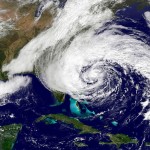
Hurricane Season
For more information » click here
‘Alarming’ Ocean Temperatures Suggest This Hurricane Season Will Be a Daunting One
An early forecast from one set of experts sees an above-average hurricane season that may rival the busiest years on record.
A key area of the Atlantic Ocean where hurricanes form is already abnormally warm, much warmer than an ideal swimming pool temperature of about 80 degrees and on the cusp of feeling more like warm bathtub water. These conditions were described by Benjamin Kirtman, a professor of atmospheric sciences at the University of Miami, as “unprecedented,” “alarming” and an “out-of-bounds anomaly.” Combined with the rapidly subsiding El Niño weather pattern, it is leading to mounting confidence among forecasting experts that there will be an exceptionally high number of storms this hurricane season. One such expert, Phil Klotzbach, a researcher at Colorado State University, said in his team’s annual forecast on Thursday that they expected a remarkably busy season of 23 named storms, including 11 hurricanes — five of them potentially reaching major status, meaning Category 3 or higher. In a typical season, there are 14 named storms with seven hurricanes and three of them major. Dr. Klotzbach said there was a “well above-average probability” that at least one major hurricane would make landfall along the United States and in the Caribbean. It’s the Colorado State researchers’ biggest April prediction ever, by a healthy margin, said Dr. Klotzbach. While things could still play out differently, he said he was more confident than he normally would be this early in the year. All the conditions that he and other researchers look at to forecast the season, such as weather patterns, sea surface temperatures and computer model data, are pointing in one direction. “Normally, I wouldn’t go nearly this high,” he said, but with the data he’s seeing, “Why hedge?” If anything, he said, his numbers are on the conservative side, and there are computer models that indicate even more storms on the way.
The United States was lucky in 2023.
Last year was unusual. Though only one hurricane, Idalia, made landfall in the United States, 20 storms formed, a number far above average and the fourth most since record keeping began. Typically, the El Niño pattern that was in force would have suppressed hurricanes and reduced the number of storms in a season. But in 2023, the warm ocean temperatures in the Atlantic blunted El Niño’s effect to thwart storms. That left Idalia as the one impactful storm of the season in the Atlantic, with 12 deaths attributed to it and over $1 billion in damage. It hit in the big bend of Florida, where few people live, and the prevailing thought among hurricane researchers is that the East Coast got lucky, Dr. Klotzbach said. That luck may change this year. The El Niño pattern is dwindling now, and the likelihood of a La Niña pattern emerging during the hurricane season could also cause a shift in the steering pattern over the Atlantic. During an El Niño weather pattern, the area of high pressure over the Atlantic tends to weaken, which allows for storms to curve north and then east away from land. That’s what kept most of the storms last year away from land. A La Niña weather pattern would already have forecasters looking toward an above-average year. The possibility of a La Niña, combined with record sea surface temperatures this hurricane season, could create a robust environment for storms to form and intensify this year. Just because there are strong signals during an El Niño year that one thing will occur, it doesn’t mean the opposite happens during a La Niña year, Dr. Kirtman said. But if the high pressure strengthens and shifts west, it will mean more hurricanes making landfall. The region where storms are most likely to form is often called the “tropical Atlantic,” stretching from West Africa to Central America and between Cuba and South America. During a La Niña year, Dr. Klotzbach said, there’s a slight increase in hurricanes forming in the western side of this main development zone — closer to the Caribbean than to Africa. When a storm forms there, it is more likely to make landfall because it’s closer to land. And while it is difficult to predict specific landfalls this far ahead of the season, the sheer odds of more storms increases the expected risk to coastal areas. Sea surface temperatures also affect the hurricane season. Over the past century, those temperatures have increased gradually. But last year, with an intensity that unnerved climate scientists, the warming ratcheted up more rapidly. And in the main area where hurricanes form, 2024 is already the warmest in a decade. “Crazy” is how Dr. Kirtman described it. “The main development region is, right now, warmer than it’s historically been,” he said. “So, it’s an out-of-bounds anomaly.” There is little doubt in his mind that we are seeing some profound climate change impacts, but scientists don’t know exactly why it is occurring so quickly all of a sudden. But it is happening, and it is likely to affect the season. “The chances of a big, big hurricane that has a large impact making landfall is definitely increased,” he said.
Early forecasts aren’t always right.
It’s reasonable to take this forecast with a grain of sea salt; the seasonal forecast in April hasn’t always been the most accurate. Colorado State University’s April forecast for the 2023 hurricane season called for a slightly below-average season with 13 named storms. Instead, there were 20. Even Dr. Klotzbach admits the April forecast isn’t always the best prediction, but its accuracy is improving. The weather can be fickle, and much can change before the season officially begins on June 1. The National Oceanic and Atmospheric Administration will issue its own forecast in late May. But for now, Colorado State and a few other forecasting groups have all called for one of the busiest seasons on record. By year’s end, Dr. Klotzbach said, he’ll be writing a scientific paper on one of two things: the incredibly active hurricane season of 2024, or one of the biggest head fakes in Atlantic hurricane season history. But he’s pretty confident it will be the former. “If it turns out to be two hurricanes,” he said, “then I should just quit and do something else.”
Read more » click here
The 2024 hurricane season could be busy.
Here’s what to expect in North Carolina.
“This is the highest prediction for hurricanes that (Colorado State University) has ever issued with their April outlook.”
The start of the 2024 hurricane season is sneaking up just as the weather warms, and forecasters are already out with their early-season predictions. But with climate change warming the oceans and air temperatures seemingly hitting new highs every month, with the European Union’s climate service declaring March to be the 10th consecutive month of record worldwide temperatures, is it only a question of how bad things will be this year? Or will Southeastern North Carolina be able to (mostly) dodge the proverbial storm bullet for another year?
What are forecasters saying?
According to forecasters at Colorado State University (CSU), who have been releasing April predictions since 1995, the 2024 season will be “an extremely active Atlantic hurricane season.” The researchers are predicting 23 named storms, with 11 becoming hurricanes and five of those becoming Category 3 or stronger systems. That’s about 170% of the usual storm activity of an average year. “This is the highest prediction for hurricanes that CSU has ever issued with their April outlook,” stated the researchers in a release.
The probability of one of those storms making landfall on the mainland U.S.:
- 62% for the entire U.S. coastline (average from 1880–2020 is 43%).
- 34% for the U.S. East Coast, including the Florida peninsula (average from 1880–2020 is 21%).
- 56% probability a hurricane will come within 50 miles of the N.C. coast, 85% for a named tropical storm.
The researchers added that the predicted storm activity is exhibiting characteristics similar to the 2010 and 2020 seasons.
How bad were 2010 and 2020?
For the Wilmington area, the 2010 hurricane season didn’t bring too many impacts − although Tropical Storm Nicole did drop more than 22 inches of rain on the Port City, flooding more than 100 roads in Brunswick County and leaving chunks of Pleasure Island underwater. But for the Atlantic basin as a whole, it was very busy, with some of the more brutal storms, particularly Alex and Karl, hammering the Caribbean and Mexico’s Yucatan Peninsula. A pair of Category 4 monsters, Danielle and Earl, also luckily stayed out mostly at sea. A decade later, 2020 proved to be the most active hurricane season ever with 30 named storms, 14 of which developed into hurricanes. That list included a record 12 U.S. landfalling storms, including Hurricane Isaias, which raked the Brunswick County beaches and knocked out power to nearly 400,000 customers in the Carolinas.
What about El Niño & La Niña in 2024?
While El Niño conditions have dominated for the past year or so, that should transition into La Niña by the time hurricane season rolls around. Dr. Michael Mann, a meteorologist and scientist at the University of Pennsylvania, said that will mean decreased wind shear in the tropical Atlantic and a more favorable environment for tropical cyclones.
Did we learn anything from the 2023 season?
Unfortunately, Mann said one of the lessons that last season reinforced was that in a world buffeted by climate change forecasters continue to have a tendency to under predict the actual number of named storms. He added that while ocean surface temperatures are somewhat retreating from the record heat we’ve seen recently, his team is still expecting to see abnormally warm water temperatures in the main development region of the Atlantic for storms. In other words, it could be a long, stormy season − so buckle up and be prepared. “It takes only one storm near you to make this an active season for you,” said CSU meteorologist Dr. Michael Bell. Hurricane season starts June 1 and runs through November.
Read more » click here
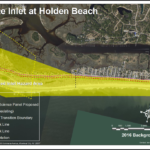
Inlet Hazard Areas
For more information » click here
.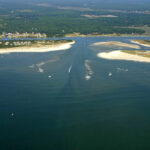
Lockwood Folly Inlet
For more information » click here.

Seismic Testing / Offshore Drilling
For more information » click here.

Offshore Wind Farms
For more information » click here
Things I Think I Think –
 Eating out is one of the great little joys of life.
Eating out is one of the great little joys of life.
Restaurant Review:
The Dinner Club visits a new restaurant once a month. Ratings reflect the reviewer’s reaction to food, ambience and service, with price taken into consideration.
///// January 2024
Name: Ruth’s Chris
Cuisine: Steakhouse
Location: 244 North Water St, Wilmington, NC
Contact: 910.343.1818 / https://www.ruthschris.com/restaurant-locations/wilmington
Food: Average / Very Good / Excellent / Exceptional
Service: Efficient / Proficient / Professional / Expert
Ambience: Drab / Plain / Distinct / Elegant
Cost: $55 Inexpensive <=20 / Moderate <=26 / Expensive <=35 / Exorbitant <=60
Rating: Three Stars
Ruth’s Chris Steak House, located inside the River Place complex in the heart of historic downtown, is renowned for its aged USDA Prime steaks. Despite being a franchisee of the largest upscale steakhouse restaurant group in the world it is everything one would expect from a high-end steakhouse. The only negative is it is very pricey, not your any-night-of-the-week restaurant. The new location is a great venue that offers some fantastic views with ample indoor and outdoor seating.
Dining Guide – Local
Old places, New faces
Name: SmacNally’s
Location: 1045 B-Var Road, Supply NC
This spot that was once known as Betty’s Waterfront Restaurant before reopening in 2020 as LouLous Waterfront Restaurant. LouLous has permanently closed. They weren’t closed long before a new eatery was announced for the space. Owners of SmacNally’s Waterfront Bar & Grill are planning a second location for 1045 B-Var Road S.W. in Supply.
Popular Outer Banks seafood restaurant planning a second location in Brunswick County
For 25 years, SmacNally’s Waterfront Bar & Grill has been serving fresh seafood and burgers in Ocracoke. Now, the owners are planning to expand the brand for the first time, and they’ll be doing so in Brunswick County. Scott McNally announced that they’ll be taking over the recently closed LouLous Waterfront Restaurant on the Intracoastal Waterway at 1045 B-Var Road S.W. in Supply. “It’s time,” McNally said. “We’ve put a lot into this brand and it’s time to grow.” McNally has decades of experience in restaurants, and together with partners Tom Burruss, Matt Bacheler and Persell Morgan, they have more than 120 years in hospitality. One caveat is they wanted to continue with the waterfront restaurant tradition that’s close to local seafood. It made the Holden Beach area ideal. “At SmacNally’s we work with fishermen, and we have a fish cleaning counter right at the end of our dock. They bring it right from there, to our restaurant. It’s usually just hours from the ocean.” That dock-to-kitchen model is one they’d like to continue in Holden Beach. If that’s not possible, they still plan to work with local markets for the freshest seafood, he said. LouLous restaurant opened in fall 2020 in what was formerly Betty’s Waterfront Restaurant. The space has indoor and outdoor dining, a bar area and slips for boat parking. McNally said they hope to open the SmacNally’s in May. “Or sooner, if possible,” he said.
Read more » click here
Peach Cobbler Factory
The dessert chain that also has a location in Carolina Beach has opened a mobile unit (with delivery options) in Holden Beach. The menu includes a variety of cobblers, puddings, cinnamon rolls and other desserts at 3247 Holden Beach Road S.W.

2024 James Beard Award – Outstanding Chef
A chef who sets high culinary standards and has served as a positive example for other food professionals while contributing positively to their broader community.
Chef Dean Neff owner of Seabird in Wilmington, is one of five in the finalist round for the Outstanding Chef category in the James Beard awards
Dining Guide – Local * Lou’s Views (lousviews.com)
Dining Guide – North * Lou’s Views (lousviews.com)
Dining Guide – South * Lou’s Views (lousviews.com)
Restaurant Reviews – North * Lou’s Views (lousviews.com)
Restaurant Reviews – South * Lou’s Views (lousviews.com)
Book Review:
Read several books from The New York Times best sellers fiction list monthly
Selection represents this month’s pick of the litter

Resurrection Walk by Michael Connelly
This is the seventh entry in the Lincoln Lawyer series of legal thriller novels. Lincoln Lawyer Mickey Haller enlists the help of his half-brother, retired LAPD homicide detective Hieronymus (“Harry”) Bosch, to exonerate a woman who’s already served five years for the murder of her sheriff’s deputy ex-husband. The title “Resurrection Walk” meaning for prisoners who have just been exonerated of their crimes, declared innocent, and set free. This walk is their resurrection back to their lives.
That’s it for this newsletter
See you next month
Lou’s Views . HBPOIN
. • Gather and disseminate information
. • Identify the issues and determine how they affect you
. • Act as a watchdog
. • Grass roots monthly newsletter since 2008

